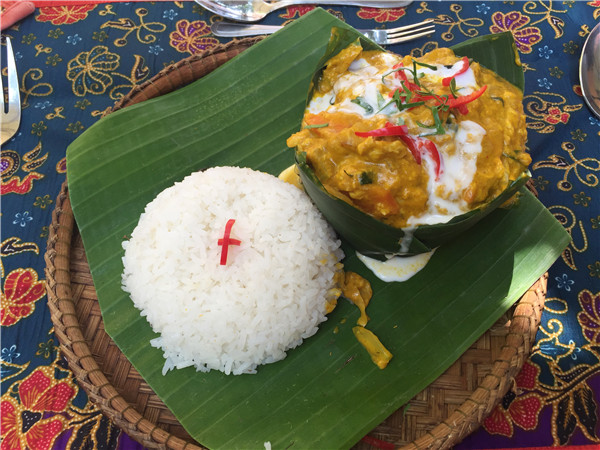Running amok in a good way
 |
|
The finished plate of fish amok, ready for eating at the cooking class. [Photo by Mike Peters / China Daily] |
After a week in Cambodia, it doesn't take long to feel like you're in a coconut-cream dream. Coconuts are almost falling out of the trees in this tropical paradise, amid the brilliant blossoms of magenta bougainvilla and cherry-colored frangipani.
Chefs here have a thousand ways to use those coconuts.
At a cooking school near our hotel in Siem Reap, a friend and I have signed up to learn how to cook amok, Cambodia's "national dish". As the country has blossomed as a travel destination in recent years, foodies are discovering that "Southeast Asian cuisine" isn't all about Thailand and Vietnam, though many of the same herbs and spices find their way into the food culture of the Khmer, the traditional name of the Cambodian people.
The country's most famous dish, fish amok, is a slightly sweet curry usually presented in a bowl crafted from banana leaves. Amok can be found everywhere from tiny street cafes to five-star hotels; in fancier presentations, it has a custard consistency, thanks to a steaming step in preparation, and sometimes a browned top.
"The amok comes in varying versions and interpretations, depending on the province and preferences," writes chef Kethana Dunnet in Cookin' Cambodian, a recipe collection from the Sugar Palm restaurant in Phnom Penh and Siem Reap. "Some are served very dry on a bed of banana leaves while some are done watery-almost like a soup."
British celebrity chef Gordon Ramsay came to Siem Reap in 2011 to learn how to make the custardlike version at The Sugar Palm, where he filmed a segment of his Great Escapes TV show.
The Food Republic website notes that the subtle flavors of lemongrass and kaffir lime go perfectly with amok's flaky white fish.
















